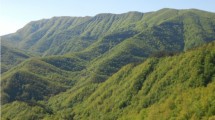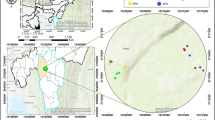Abstract
The role of swidden fallows in carbon storage is poorly understood, especially in Myanmar, due to the complex and dynamic characteristics of fallows and limited available data. We studied fallow forests formed as a consequence of Karen swiddeners in the Bago Mountains, Myanmar, assessing above- and belowground biomass recovery and soil carbon storage in fallow forests using a chronosequence approach. The accumulated total biomass was 12.13–356.95 Mg ha−1, the accumulated carbon stock was 5.70–167.77 Mg C ha−1, and the soil carbon stock was 5.70–167.77 Mg C ha−1 in the fallow forests. Our analysis suggested that the fallow forests in this study should recover to the total biomass accumulation of old forests after 20–35 years. We established a curve of total biomass accumulation in the fallows against age that can be easily used when the age of the fallows is known. Based on soil carbon analysis, total carbon storage fluctuated with fallow age and decreased with soil depth. The overall soil carbon accumulation in fallow forest soil was 43.63–70.11 Mg ha−1. This study contributes to the understanding of fallow forest and swidden agricultural system carbon stocks and can be used for planning future agreements, such as Reducing Emissions from deforestation and forest degradation in developing countries (REDD+), at national and regional levels.





Similar content being viewed by others
References
Boserup E (1965) The conditions of agricultural growth: the economics of agrarian change under population pressure. George Allen & Unwin LTD, London
Brown S (1997) Estimating biomass and biomass change of tropical forests: a primer (FAO forestry paper 134). FAO, Rome
Bruun T, de Neergaard A, Lawrence D, Ziegler A (2009) Environmental consequences of the demise in swidden cultivation in Southeast Asia: carbon storage and soil quality. Hum Ecol 37(3):375–388
Chan N, Takeda S, Suzuki R, Yamamoto S (2013) Establishment of allometric models and estimation of biomass recovery of swidden cultivation fallows in mixed deciduous forests of the Bago Mountains, Myanmar. For Ecol Manag 304:427–436
Chazdon RL (2003) Tropical forest recovery: legacies of human impact and natural disturbances. Perspect Plant Ecol Evolut Syst 6(1–2):51–71
Christanty L, Mailly D, Kimmins JP (1996) “Without bamboo, the land dies”: biomass, litterfall, and soil organic matter dynamics of a Javanese bamboo talun-kebun system. For Ecol Manag 87(1–3):75–88
Coomes OT, Grimard F, Burt GJ (2000) Tropical forests and shifting cultivation: secondary forest fallow dynamics among traditional farmers of the Peruvian Amazon. Ecol Econ 32(1):109–124
Cramb RA, Colfer CP, Dressler W, Laungaramsri P, Le Q, Mulyoutami E, Peluso N, Wadley R (2009) Swidden transformations and rural livelihoods in Southeast Asia. Hum Ecol 37(3):323–346
Dalle SP, Blois SD (2006) Shorter fallow cycles affect the availability of non-crop plant resources in a shifting cultivation system. Ecol Soc 11(2):2
Ellen RF (2012) Studies of swidden agriculture in Southeast Asia since 1960: an overview and commentary on recent research and syntheses. Asia Pac World 3(1):18–38
Erni C (2008) The concept of indigenous peoples in Asia: A resource book. International Work Group for Indegenous Affairs (IWGIA) & AIPP, Chiang Mai/Copenhagen
Fonseca W, Alice FE, Rey-Benayas JM (2012) Carbon accumulation in aboveground and belowground biomass and soil of different age native forest plantations in the humid tropical lowlands of Costa Rica. New For 43:197–211
Fox J, Fujita Y, Ngidang D, Peluso N, Potter L, Sakuntaladewi N, Sturgeon J, Thomas D (2009) Policies, political-economy, and swidden in Southeast Asia. Hum Ecol 37(3):305–322
Fukushima M, Kanzaki M, Thein HM, Minn Y (2007) Recovery process of fallow vegetation in the traditional Karen swidden cultivation system in the Bago Mountain Range, Myanmar. Southeast Asian Stud 45(3):303–316
Fukushima M, Kanzaki M, Hara M, Ohkubo T, Preechapanya P, Choocharoen C (2008) Secondary forest succession after the cessation of swidden cultivation in the montane forest area in Northern Thailand. For Ecol Manag 255(5–6):1994–2006
Funakawa S, Tanaka S, Shinjyo H, Kaewkhongkha T, Hattori T, Yonebayashi K (1997) Ecological study on the dynamics of soil organic matter and its related properties in shifting cultivation systems of Northern Thailand. Soil Sci Plant Nutr 43(3):681–693
Gibbs HK, Brown S, Niles JO, Foley JA (2007) Monitoring and estimating tropical forest carbon stocks: making REDD a reality. Environ Res Lett 2(4):1–13
Hashimoto T, Kojima K, Tange T, Sasaki S (2000) Changes in carbon storage in fallow forests in the tropical lowlands of Borneo. For Ecol Manag 126:331–337
Higashi S (2015) An alternative approach to land and forest management in northern Lao PDR. In: Erni C (ed) Shifting cultivation, livelihood and food security—new and old challenges for indigenous people in Asia. FAO, IWGIA and AIPP, pp 253–290
IPCC (2006) Chapter 4: Forest Lands. In: Eggleston S, Buendia L, Miwa K, Ngara T, Tanabe K (eds) 2006 IPCC Guidelines for National Greenhouse Gas Inventories. Institute for Global Environmental Strategies (IGES), Kanagawa, pp 1–83
Isagi Y, Kawahara T, Kamo K, Ito H (1997) Net production and carbon cycling in a bamboo Phyllostachys pubescens stand. Plant Ecol 130(1):41–52
Kameda C (2015) Factors influencing the changes of swidden agriculture and its development in rural livelihoods of nothern Laos (PhD Dissertation). Graduate School of Agriculture, Kyoto University, Kyoto, Japan
Karthik T, Veeraswami G, Samal P (2009) Forest recovery following shifting cultivation: an overview of existing research. Trop Conserv Sci 2(4):374–387
Kenzo T, Ichie T, Hattori D, Itioka T, Handa C, Ohkubo T, Kendawang JJ, Nakamura M, Sakaguchi M, Takahashi N, Okamoto M, Tanaka-Oda A, Sakurai K, Ninomiya I (2009) Development of allometric relationships for accurate estimation of above- and below-ground biomass in tropical secondary forests in Sarawak, Malaysia. J Trop Ecol 25:371–386
Kiyono Y, Ochiai Y, Chiba Y, Asai H, Saito K, Shiraiwa T, Horie T, Songnoukhai V, Navongxai V, Inoue Y (2007) Predicting chronosequential changes in carbon stocks of pachymorph bamboo communities in slash-and-burn agricultural fallow, northern Lao People’s Democratic Republic. J For Res 12(5):371–383
McNicol IM, Berry NJ, Bruun TB, Hergoualc’h K, Mertz O, de Neergaard A, Ryan CM (2015) Development of allometric models for above- and belowground biomass in swidden cultivation fallows of Northern Laos. For Ecol Manag 357:104–116
Mertz O (2009) Trends in shifting cultivation and the REDD mechanism. Curr Opin Environ Sustain 1(2):156–160
Mertz O, Leisz S, Heinimann A, Rerkasem K, Thiha Dressler W, Pham V, Vu K, Schmidt-Vogt D, Colfer CP, Epprecht M, Padoch C, Potter L (2009) Who counts? Demography of Swidden cultivators in Southeast Asia. Hum Ecol 37(3):281–289
Nair PK (1993) An introduction to agroforestry. Springer, New York
Niiyama K, Kajimoto T, Matsuura Y, Yamashita T, Kassim AR, Ripin A, Noor NSM (2005) Allometric relationship between stem diameter, tree height, leaf, stem and root biomass in Pasoh Forest Reserve. In: Okuda T, Kondo T (eds) Annual report of NIES/FRIM/UPM joint project tropical ecology and biodiversity 2005. Alles Druck Inc., Tsukuba, pp 22–36
Niiyama K, Kajimoto T, Matsuura Y, Yamashita T (2010) Estimation of root biomass based on excavation of individual root systems in a primary dipterocarp forest in Pasoh Forest Reserve, Peninsular Malaysia. J Trop Ecol 26(3):271–284
Oberndorf RB (2012) Legal review of recently enacted farmland law and vacant, fallow and virgin lands management law: improving the legal & policy frameworks relating to land management in Myanmar. Forest Trends Association, Washington, DC
Oo TN (2009) Carbon sequestration of tropical deciduous forests and forest plantations in Myanmar (Dissertation). Seoul National University, Seoul
Oo TN, Lee DK, Combalicer M (2007) Carbon sequestration of teak (Tectona grandis Linn. f.) plantations in the Bago Yoma region of Myanmar. J Korean For Soc 96(5):602–608
Padoch C, Coffey K, Mertz O, Leisz SJ, Fox J, Wadley RL (2007) The demise of Swidden in Southeast Asia? Local realities and regional ambiguities. Geografisk Tidsskrift 107(1):29–41
Peters WJ, Neuenschwander LF (1988) Slash and burn: farming in the third world forest. University of Idaho Press, Idaho
Ramakrishnan PS (1992) Shifting agriculture and sustainable development: An interdisciplinary study from North-Eastern India. UNESCO, Paris
Roshetko JM, Delaney M, Hairiah K, Purnomosidhi P (2002) Carbon stocks in Indonesian homegargen systems: can smallholder systems be targeted for increased carbon storage? Am J Altern Agric 17(2):1–11
Schmidt-Vogt D (2001) Secondary forests in swidden agriculture in the highlands of Thailand. J For Sci 13(4):748–767
Schmidt-Vogt D, Leisz S, Mertz O, Heinimann A, Thiha T, Messerli P, Epprecht M, Cu P, Chi V, Hardiono M, Dao T (2009) An assessment of trends in the extent of swidden in Southeast Asia. Hum Ecol 37(3):269–280
Silver WL, Ostertag R, Lugo AE (2000) The potential for carbon sequestration through reforestation of abandoned tropical agricultural and pasture lands. Restor Ecol 8(4):394–407
Singh AN, Singh JS (1999) Biomass, net primary production and impact of bamboo plantation on soil redevelopment in a dry tropical region. For Ecol Manage 119(1):195–207
Suzuki R, Takeda S, Keh SK (2004) The impact of forest fires on the long-term sustainability of taungya teak reforestation in Bago Yoma, Myanmar. Tropics 14(1):87–102
Suzuki R, Takeda S, Thein HM (2007) Analysis of land use history and fallow vegetation recovery: a case study of shifting cultivation by the Karen in the Bago Mountains. Myanmar. Southeast Asian Studies 45(3):343–358
Suzuki R, Takeda S, Thein HM (2009) Effect of Slash-and-burn on Nutrient Dynamics during the Intercropping Period of Taungya Teak Reforestation in the Bago Mountains, Myanmar. Trop Agric Dev 53(3):82–89
Swe PP, Winn O, Win S (2004) Study on the changes of soil properties in area affected by taungya method. FRI (Forest Research Institute, Yezin) Leaflet 4:135–165
Tanaka S, Ando T, Funakawa S, Sukhrun C, Kaewkhongkha T, Sakurai K (2001) Effect of burning on soil organic matter content and N mineralization under shifting cultivation system of Karen people in Northern Thailand. Soil Sci Plant Nutr 47(3):547–558
The Pyidaungsu Hluttaw (2012a) The farmland law Myanmar 2012. The Pyidaungsu Hluttaw, Naypyitaw
The Pyidaungsu Hluttaw (2012b) The vacant, fallow and virgin lands management law Myanmar 2012. The Pyidaungsu Hluttaw, Naypyitaw
Tsutsumi T, Yoda K, Sahunalu P, Dhanmononda P, Prachaiyo B (1983) Forest: felling, burning and regeneration. In: Kyuma K, Patrintra C (eds) Shifting cultivation: an experiment at Nam Phrom, Northeast Thailand, and its implications for upland farming in the monsoon tropics. Tokyo University of Agriculture, Tokyo, pp 13–62
Van Do T, Osawa A, Thang NT (2010) Recovery process of a mountain forest after shifting cultivation in Northwestern Vietnam. For Ecol Manage 259(8):1650–1659
Van Do T, Osawa A, Thang NT, Van NB, Hang BT, Khanh CQ, Thao LT, Tuan DX (2011) Population changes of early successional forest species after shifting cultivation in Northwestern Vietnam. New For 41:247–262
Watson H (1923) A note on the Pegu Yoma forests. Office of the superintendent, Governtment printing, Rangoon, Burma
Yiming L, Peng L, Wanzhang W (1998) Studies on dynamics of carbon and nitrogen elements in Dendrocalamopsis oldhami forest. J Bamboo Res 17(4):25–30
Yiming L, Huicong L, Peng L (2000) Biomass structure and energy distribution in Dendrocalamus latiforus Munro. population. J Bamboo Res 19(4):36–41
Acknowledgments
This study was financially supported by Grants-in-Aid from the Ministry of Education, Culture, Sports, Science and Technology, Government of Japan (21255003, 15K01877). Great thanks go to Ministry of Environmental Conservation and Forestry, Myanmar, for kindly granting permission to conduct this study in the Bago Mountains, and to the local people at S village for their support and collaboration. Special thanks also go to Unit of Synergetic Studies for Space, Kyoto University (宇宙ユニット) for their financial support to present the outline of this research output at IUFRO2014, Salt Lake City, USA.
Author information
Authors and Affiliations
Corresponding author
Electronic supplementary material
Below is the link to the electronic supplementary material.
Rights and permissions
About this article
Cite this article
Chan, N., Takeda, S., Suzuki, R. et al. Assessment of biomass recovery and soil carbon storage of fallow forests after swidden cultivation in the Bago Mountains, Myanmar. New Forests 47, 565–585 (2016). https://doi.org/10.1007/s11056-016-9531-y
Received:
Accepted:
Published:
Issue Date:
DOI: https://doi.org/10.1007/s11056-016-9531-y




